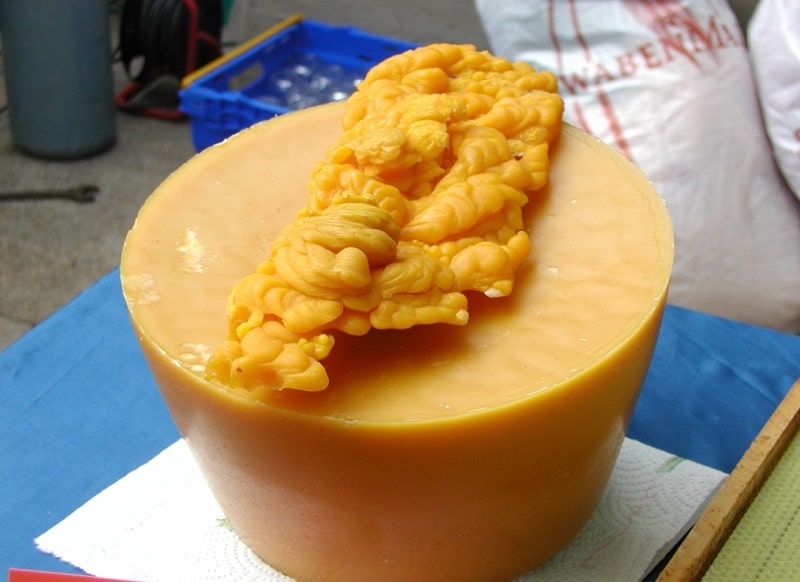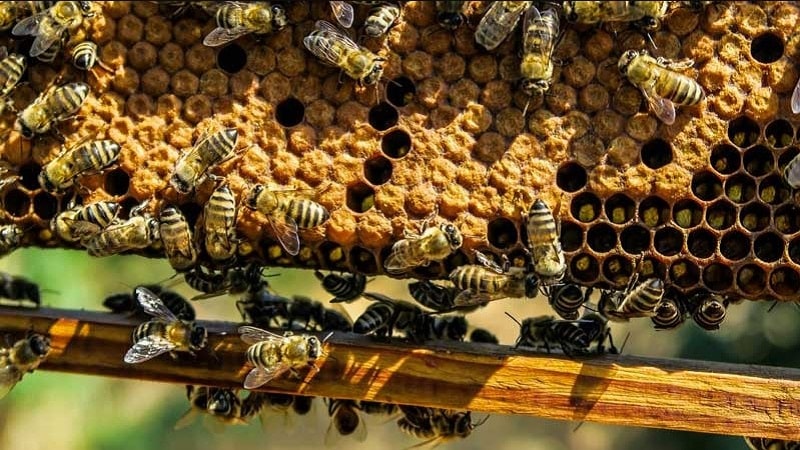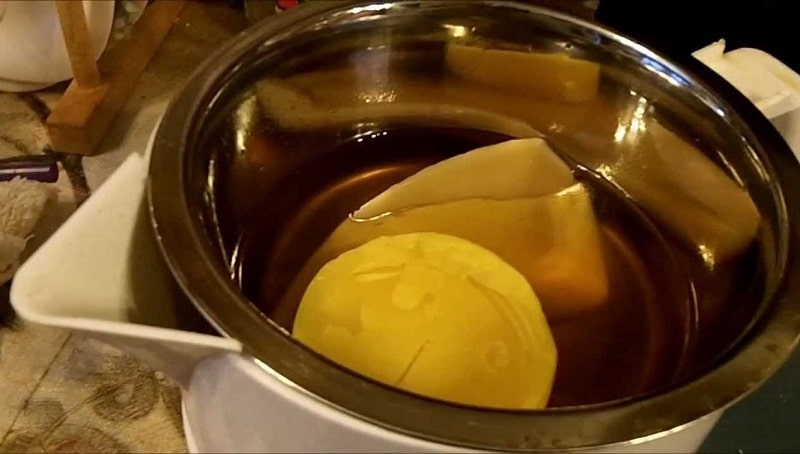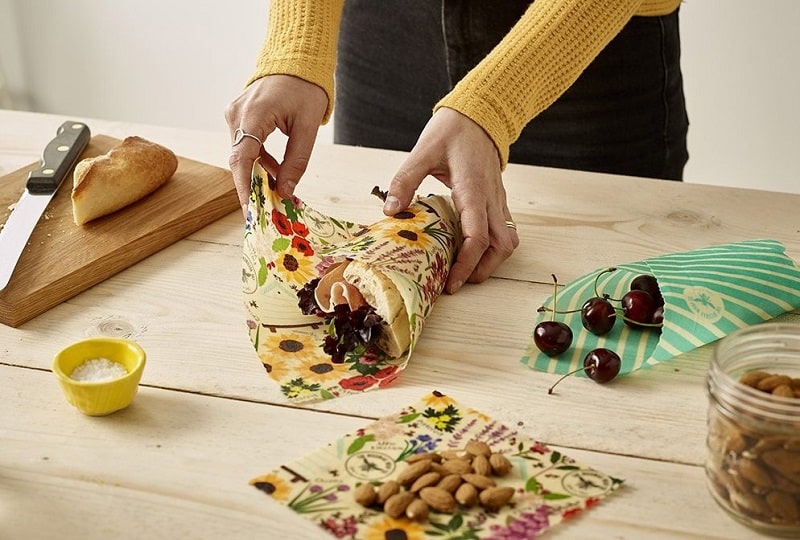When you tell someone you are a beekeeper, the first thing they think about is honey. While many people are aware of beeswax, few inquire about it. It is arguably the most underappreciated, but one of the most valuable products produced by bees. Bees could not exist without it since they utilize it to build their nests. And the colony could not function without beeswax. So do you know how to clean and melt beeswax? What is beeswax used for?

Where does beeswax come from?
All insects make wax, which they utilize to keep their bodies from drying out. Honeybees, on the other hand, are the only insects that generate beeswax. When it is needed for nest construction, they make a huge amount of it.
Beeswax is produced by four pairs of specialized wax glands located under the worker bee’s abdomen plates. It includes about 300 components and requires bees to consume a large amount of sugar, typically in the form of nectar. The development of the oenocytes that generate wax is dependent on the worker bee ingesting pollen in the first few days of life.
Wax is largely utilized by bees to construct combs. The combs in a natural cavity hang from the top and are expanded downwards as needed by the colony. When bees produce wax for comb-building, you may notice them hanging in chains in space.

How is beeswax collected?
The simplest approach to expanding your wax collection is to save the capping during honey extraction. Cut through the cells so that the remaining comb surface is level with the frame’s top and bottom bars. Because the combs are uniform in thickness, they can be replaced in any order in the super box after extraction.
Because the combs are uniform in thickness, they can be replaced in any order in the super box after extraction. Collect the cappings and any comb bulges in a container. Because these will inevitably include some honey, strain the cappings through a sieve and collect the drained honey. If you have a high number of cappings, you will need to design a larger sieve. The honey can be added to your main harvest after filtering it if necessary.
How to clean beeswax?
Dirt particles are present in all the wax, including the clean-looking capping. As a result, these must be removed before using the wax to produce candles, polish, or, more specifically, cosmetic goods.
Because hard water contains compounds that react with beeswax, wash your capping with soft water or clean rainwater. Pour your wax into a stainless steel or glass container and top it off with water. Before drying the capping, stir the contents and drain the water.
Every time you filter wax, some of it is retained in the filter material. It’s preferable to wait until you’ve gathered a reasonable amount, say 1 pound (0.5 kg), before dealing with it. Dry cappings can be kept in a plastic bag in a cool environment, such as the freezer. Any traces of honey at room temperature may promote mold growth.
How to melt beeswax?
A double boiler is most likely the safest way to melt the wax. However, a replacement can be constructed by placing a glass or stainless steel bowl on top of a small diameter pan containing some water.
You can melt beeswax without using a double boiler. Instead, you can melt wax straight into a container, add some soft water and make sure the container is at least twice the size of the wax.
Is it possible to melt beeswax in the microwave? Yes, you can continue to melt your wax in the microwave, but do so in short bursts and stirring in between. Beeswax can be melted in a microwave using short bursts of electricity in a basin containing soft water.

How to clean melt beeswax?
If you want to remove small dirt particles, the filter you employ must be quite fine. We recommend using disposable nappy liners in two layers. An old cotton sheet or surgical lint might also be used. You will have to sacrifice your filter as it becomes clogged with dirt and wax. This implies that lint is a pricey alternative, but it is one of the best if you want really clean wax for a show or cosmetics. Use its hairy side to avoid getting fibers in your clean wax.
Rubber bands can be used to maintain the filter material at one end of a clean tin can that has had both ends removed. Pour a little amount of the liquid wax into the tin while holding it over a collecting receptacle. Keep in mind, you will have a large mess to clean up if you fill-up the tin and the filter blocks.
>>> Read more: How to Processing Beeswax at Home For Beginners
What can you use beeswax for?
Traditional uses for beeswax include polishing and molded or dipped candles. Beeswax is also found in many skin treatments and lip balms. Remember that if you wish to sell beeswax cosmetics, the ingredients must be legal. However, if they are used for your personal use, you are exempt from the severe testing standards. Lotion bars are more convenient and popular than liquid kinds.
Beeswax candle making
One of beeswax’s traditional applications is polish. Candles are the other option. With your own bees and beeswax, there’s nothing stopping you from manufacturing your own candles, which will make excellent Christmas gifts.
There are two critical factors for successful candle production. To begin, the wax must be free of contaminants. If there are dirt particles or little water droplets in the wax, the candle will splutter as it burns. Second, and maybe most crucially, the wick must be the precise size.

The molds
We recommend that you use the silicone molds that are now readily available instead of making them yourself. They are pretty pricey, but if you maintain them well, they will last a long time and allow you to manufacture hundreds of candles.
They come in a wide variety of designs, including bears with honeypots, frogs and pyramids. Molds for tea lights and floating candles, such as roses and sunflowers, are also available, giving you a variety of options.
Lotion bar
Try making some lotion bars with beeswax. A lotion bar is a solid moisturizer that resembles soap yet functions as a lotion. The heat from your palms melts the bar, allowing you to rub it into your skin.
Beeswax is blended with base oils including sunflower, olive, and castor oils, as well as a solid butter like coconut, cocoa butter, or avocado oil. To prevent the oils from becoming rancid, about 1% vitamin E is added as a preservative.
You can add essential oils if desired. For example, neem oil repels insects, lavender oil promotes relaxation, and tea tree oil has antibacterial effects. There are other more oils available, so you can make your own selection. When you want to use it, simply take the lotion bar and rub it between your palms. This will melt the surface, which can then be rubbed over any part of your body that requires moisturizing.
